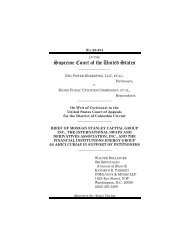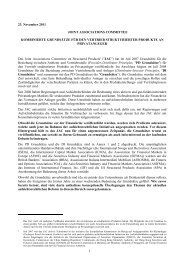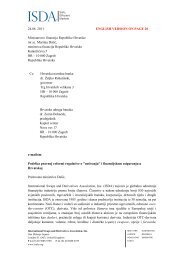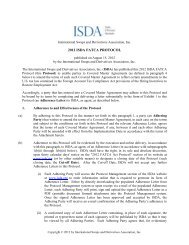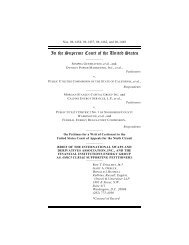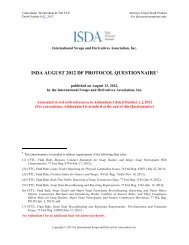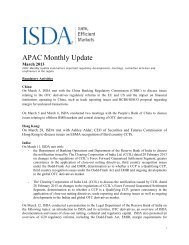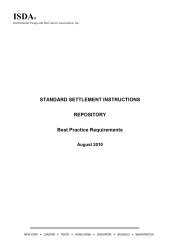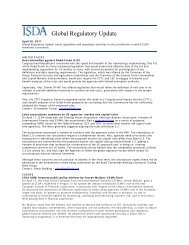ISDA Margin Survey 2013
ISDA Margin Survey 2013
ISDA Margin Survey 2013
Create successful ePaper yourself
Turn your PDF publications into a flip-book with our unique Google optimized e-Paper software.
17<br />
Table 4.1 shows that for “clean” CSAs (where eligible collateral is cash only in a single currency or in multiple<br />
currencies that are aligned to the underlying swap cashflows, such as a single-currency CSA, a siloed CSA, or a<br />
Standard CSA) over 80% of market participants responding would theoretically value swaps at OIS where<br />
rehypothecation is permitted. This demonstrates the degree to which there is strong market consensus on OIS<br />
valuation for this special case set of circumstances, which has been built up over the past two to three years. It<br />
is notable that “clean” CSAs of the types mentioned above generate swap valuations that approach the clearing<br />
house valuation of similar products, and in fact the Standard CSA produces valuations that are exactly equivalent<br />
to LCH swap valuation; this convergence in valuation approach across cleared and non-cleared segments of the<br />
market is not coincidental.<br />
In terms of the historically most common valuation basis of LIBOR, only 5-10% of firms would theoretically still<br />
use this basis in all of the scenarios captured by the survey.<br />
For other collateralization scenarios, the consensus is less strong. For instance, in situations where collateral is<br />
not rehypothecable, a fairly consistent response rate of about 15-17% suggest that they would theoretically<br />
value swaps based on their own cost of funds, which would align the discount rate to the rate at which the<br />
future cashflows will be funded but only where collateral is received; a further 16-20% would theoretically use<br />
the more nuanced approach of discounting at OIS for payables and cost of funds for receivables. Thus, around<br />
31-37% of firms would theoretically use a funding sensitive discount rate for CSAs containing nonrehypothecable<br />
collateral, whereas by contrast between 32% and 50% of firms would theoretically discount at<br />
OIS in this situation.<br />
In non-clean CSA scenarios where rehypothecation is permitted, but the eligible collateral is not currencyaligned<br />
or includes securities, we see other contrasts. Some 25-35% of firms would theoretically use a discount<br />
curve constructed from the cheapest-to-deliver collateral currency at each point, option adjusted, which is a<br />
sophisticated treatment of a highly complex collateralization scenario. However, 36-50% would theoretically<br />
simply discount at OIS regardless of what collateral may be delivered by their counterparty, indicating that there<br />
is still substantial work to be done across the market to achieve consistent valuation of complex CSA structures,<br />
or to replace these CSAs with “clean” structures such as the Standard CSA that would produce straightforward<br />
OIS valuations.<br />
For CSAs containing securities as collateral (whether government bonds, agencies or corporate bonds), around<br />
22-23% of firms would theoretically discount based on either OIS or LIBOR plus the repo funding spread for the<br />
instrument. In practice these instruments fund at a wide range of spreads in repo markets, but with a markedly<br />
different (lower) risk profile than the same securities posted under CSAs, where (unlike a repo) the posting may<br />
be at any future point in time, and for unlimited amount and unlimited duration, and with no ability for the<br />
receiving party to decline or break the posting.<br />
While it must be remembered that table 4.1 contains the theoretical responses of firms, it is perhaps useful as a<br />
gauge of the direction of swap valuation under different CSA conditions in the future.<br />
<strong>ISDA</strong> <strong>Margin</strong> <strong>Survey</strong> <strong>2013</strong> June <strong>2013</strong>



